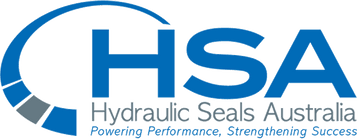Within a Hydraulic cylinder, the function each component plays is crucial to ensuring optimal performance and longevity of the cylinder. In this blog, part 2 of 2 in this series, we will look at the common excavator gland arrangement and the role each component plays.
Most arrangements comprise of the following components:
Internal
- Rod wiper (A)
- Rod seal (B)
- Buffer seal (C)
- DU bush (D)
External
- Static pressure seal (E)
- Environmental O-ring (F)
We can see in the picture below the layout and location of each item in the gland.

A) Rod Wiper
This profile can vary between makes and models, however the same principals apply. This component comprises of a durable polyurethane wiping lip bound to a steel case helping provide rigidity and a locked in press fit. The durable polyurethane wiping lip keeps out dust and fine particles while also preventing mud and other harsh external contaminants from entering the cylinder.
B) Rod Seal
Commonly found arrangements include seals with anti-extrusion rings or full radial back ups as shown. The backup provides support and protection for the rod seal minimizing the extrusion gap and potential damage to the seal by providing additional structural reinforcement. This is particularly crucial in high-pressure hydraulic systems such as excavator cylinders. For optimal sealing the rod seal must be made from a quality material that has minimal wear, good abrasion resistance and can still maintain optimal sealing form while under duress from fluctuations in system and operational pressures.
C) Buffer Seal
Designed to protect the primary rod seal by absorbing pressure spikes, minimizing the effect of these spikes before they damage the primary rod seal. This profile includes an anti-extrusion ring that provides resistance against extrusion caused by pressure spikes. The inclusion of relief pads and venting eliminates pressure traps between the buffer and rod seal cavaities.
D) DU Bush
This DU bush is a thin walled steel guide with a axial split designed to be pressed into the gland housing. The bush is bronze plated and then coated with a layer of PTFE. The PTFE eliminates stick slip by way of its low coefficient and offers a tight guide against the rod helping keep the rod running true.
E) Static pressure seal
Used to seal the gland against the bore thus preventing fluids from getting out past the thread into the environment. Most commonly found with O-Ring and back up however HSA strongly recommend our GS seals as pictured. These GS designs resist extrusion and increase in sealing force as the cylinder pressure increases creating a excellent sealing barrier.
F) Environmental O-Ring
This O-Ring sees no pressure with its sole purpose to eliminate external environmental factors such as dirt, dust and water from entering the cylinder. These environmental factors can cause damage to surfaces and thread i.e. rust and abrasion as well as damage to the Static pressure seal groove creating a failure point.
At HSA, we exclusively offer seal components that are trusted and proven performers, supplied by our key global partners who possess decades of experience and expertise. When you are aware that the sealing product you are installing in your cylinders is of the best quality and understand the pivotal role these items play in your cylinder's performance, you can confidently select your seals and trust that your cylinder will offer many years or reliable service




